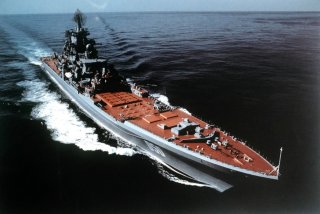Why Russia’s Nuclear Battlecruiser Has Some Problems
One of the largest and heaviest surface combatant ships in the world, the Kirov-class nuclear-powered battlecruiser Admiral Nakhimov was commissioned in 1988.
Here's What You Need to Remember: These prodigious armament updates will be accompanied by a modernized radar and onboard electronics suite. If successful, this refit will place Admiral Nakhimov high among the ranks of Russia’s most capable large surface warships.
The post-refit handover of Russia’s Admiral Nakhimov battlecruiser has reportedly been postponed.
A defense industry source told Russian news outlet TASS earlier this week that the delivery of Admiral Nakhimov has been pushed back “due to problems with suppliers.” The source did not give a concrete timeline, but told TASS that the handover is “postponed until 2023 at best.”
One of the largest and heaviest surface combatant ships in the world, the Kirov-class nuclear-powered battlecruiser Admiral Nakhimov was commissioned in 1988 under a different name: Kalinin. The Kirov class has its roots in a prominent strain of Soviet 1970’s military thinking. Initially conceived as a battlecruiser— that is, a lighter and faster variant of battleship— to counter the U.S. navy’s latest submarines with its large payload of SS-N-14 anti-submarine missiles, the Kirov line grew into another, no less important role: namely, containing the threat from U.S. carrier strike groups (CSG’s). Armed with twenty onboard P-700 Granit anti-ship missiles, Kirov-class vessels were meant to threaten U.S. aircraft carriers and other large surface ships. There was yet another, broader strategic goal: Kirov-class battlecruisers were intended to operate alongside a class of dedicated modern aircraft carriers, heralding a new era of Soviet global power projection.
The grand strategic visions driving the Kirov-class project collapsed alongside the Soviet Union. The ill-fated Admiral Kuznetsov became the only carrier of its line, and is now undergoing major repairs following a series of catastrophic incidents including an onboard fire and collapsed drydock. Meanwhile, the four Kirov-class cruisers—Admiral Ushakov, Admiral Lazarev, Kalinin, and Petr Velikiy— fell into disrepair over the 1990s. Two of these, Petr Velikiy and Kalinin, were deemed to be in a salvageable state. Kalinin was renamed to Admiral Nakhimov in 1992, and has been docked since 1999. Modernization work on Nakhimov began in earnest only in 2013. As part of its deep refit, Admiral Nakhimov will be upgraded to carry 3M22 Tsirkon winged, anti-ship hypersonic cruise missiles, Kalibr cruise missiles, and Otvet anti-submarine missiles, as well as the Fort-M (a naval S-300 variant) and Pantsir-M air defense systems. The Russian navy is likewise reportedly planning to outfit Admiral Nakhimov, as well as its counterpart Petr Velikiy, with a naval version of the S-400 missile system. These prodigious armament updates will be accompanied by a modernized radar and onboard electronics suite. If successful, this refit will place Admiral Nakhimov high among the ranks of Russia’s most capable large surface warships.
Initially projected to rejoin the Navy in 2018, the Nakhimov’s handoff was subsequently postponed to 2022. Sevmash CEO Mikhail Budnichenko repeated the 2022 projection at Russia’s ARMY 2020 military exhibition. That date was also reaffirmed by Russia’s United Shipbuilding Corporation (UAC) head Alexei Rakhmanov. “We are planning to complete the ship’s repairs in 2022,” said Rakhmanov during Shipbuilders’ Day celebrations in 2020. Russian officials have not formally confirmed this latest alleged delay to 2023 or later, nor has its cause been identified as of the time of writing.
Mark Episkopos is a national security reporter for the National Interest. This article first appeared earlier this year.
Image: Wikipedia.

